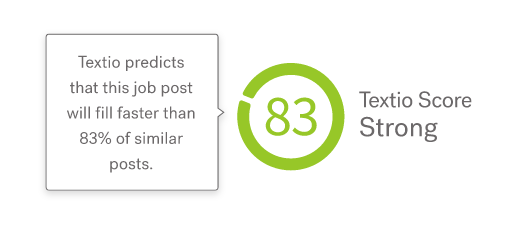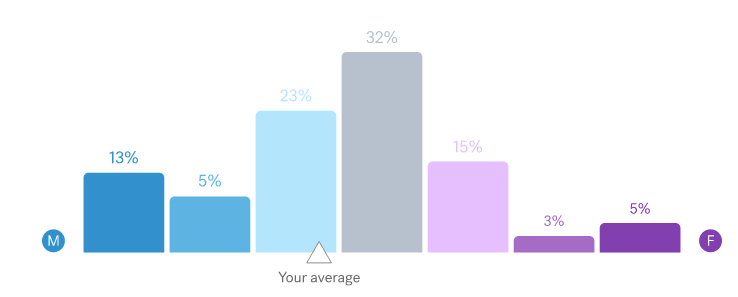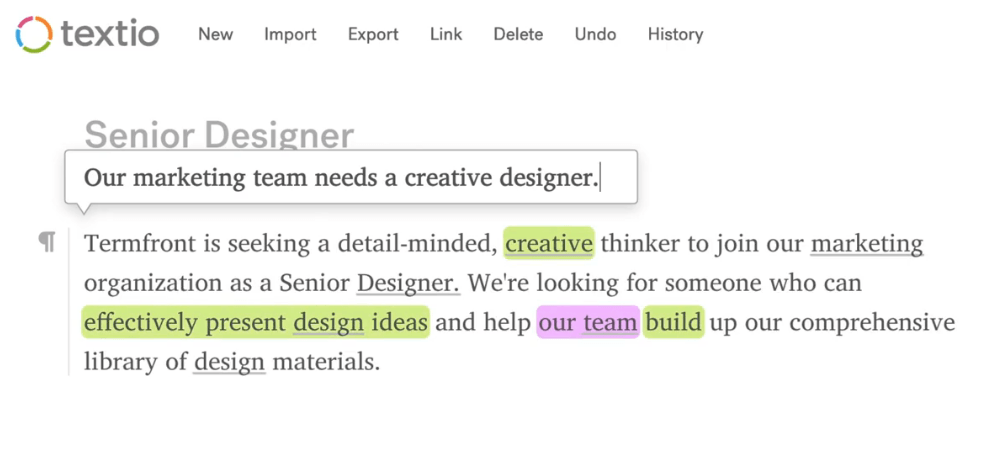Textio.com Reducing Gender Bias in Hiring with AI?

Textio uses AI to recommend word-choices and write job postings for companies to improve the demographic diversity of its job applicants and speed and efficacy of hiring. Is it the future of hiring? How will it weather the storm of an economic downturn with massive unemployment?
Intro
I recently became aware of an interesting company called Textio.com (https://textio.com) which has productized a very creative and impressive interactive AI text-analysis and recommendation software for a good cause, reducing gender and age bias in hiring practices. Once a company hires Textio, they upload their job postings and data regarding who has applied and received job postings in the past, and Textio will analyze these job postings to identify specific wording changes which could reduce bias in hiring of females or males in fields in which they are under-represented, and recently expanded into reducing agism and ablism and also reduce the time to hiring through wording changes in blog posting. Their customers include Nvidia, McDonalds, CVS, Evernote, and Johnson & Johnson, and only were founded in 2015. Some notable successes include J&J’s reportedly getting an additional 90,000 female applicants (9% increase) in its pipeline last year after using Textio recommendations, Nvidia reported filling jobs twice as quickly, and Evernote’s job applications tripled.
They call their product “Augmented Writing” and as you can see below, users can enter a job posting and see highlights of word phrases which are identified as affecting the bias of applicant demographic likelihood. Certain words are said to bias applicants toward men, while others may bias toward women, or simply reduce the likelihood of applicants in general.
Textio reports that there isn’t a specific list of words which are male or female biased, but that it differs by industry, and they train their algorithm on the company’s own historical hiring data. They have found that even geographic regions have different effects of language for specific jobs on application demographics. Companies can track their gender inclusion over time with analytics reports like below:
Value Creation
Textio creates value for companies by increasing the diversity of their workforce, and increasing job application rates and potentially even hiring speed. They provide insight into the ways that text language may be affecting the way potential applicants consider applying, and have expanded into services to actually take initial text prompts and create full job postings with eloquent language for you, potentially saving people time in the writing process.
Product Types:
Textio offers the following features:
Hiring Score: A generalized metric for predicted job application rate compared to “similar posts”
Gender Bias Meter: Another visualization of the potential demographic split of your applicants due to your word-choices. It’s not clear if this accounts for bias in specific job pool, but is meant to be a rough barometer.
Central Library: A resource for companies to collect hiring documents for analysis and reference to guide their hiring staff with data-driven best practices.
Textio Flow: Their most technically advanced offering which turns short phrases into complete prose.
Risks:
Firstly, it is hard to take at face-value that their suggestions are so concretely accurate, down to the adjective level. They aren’t doing A/B testing of language as far as I know on job postings, and are simply doing retrospective analytics and assuming other confounders are not at play. They also have very little data to train on, especially for smaller clients, as they limit themselves to domain and company specific data. However, their customer case studies do sound impressive, so it’s possible that they have reason to be confident in their recommendations. Boldly recommending word changes definitely adds trustworthiness to the UI, and it appears that their recommendations/analyses are actionable as opposed to many data-driven business AI products.
Their product is very focused on training data to determine how applications affect hiring demographics, but their goal is actually getting more diverse people hired. Their software as of now, does not help with biases in interview and hiring decisions, even though they may have the data to determine where that bias lies.
There’s also a risk that by raising awareness of how language affects the gender, age, and disability status of job applicants, companies may use it to intentially bias hiring toward young, male, able-bodied people. Insurance companies for example, may especially be interested in a product like this, even though it appears to be against the pro-social goals of the company.
They recently reported laying off 30 employees in the context of COVID-19 and skyrocketing unemployment (20 percent of its team). They are reportedly investigating expanding their services to help job applicants to help them position their job applications to improve hiring rates. They say this may even help the people they laid off to get jobs again.
Competitors:
Their competitors exist in traditional augmented writing outside of hiring, including Grammarly and spell/grammar check software built into Microsoft Word and Google Docs which also uses AI. Job sites are additional potential competitors as they have significant amounts of data regarding job postings and applicant demographics, but may end up being a potential partner by contributing their AI experience.
Recommendations for Value Capture:
It’s a challenging time right now, as the economy is in a downturn and there are high rates of unemployment. However, business goes on, and I think they can expand into a couple new markets:
– Expand into augmented writing for sales emails and social media. This is a large amount of text writing for company-critical text, and has the potential for response demographic analysis and optimization.
– Perform analytics on interviewer bias for multi-party interviews, and give interviewers a score. This can help them to achieve their stated mission of improving workforce diversity.
– Provide services for people looking for jobs. This will be a very large market and many people will appreciate help crafting their resumes. Gender bias might not be as critical of a factor, but general hire-ability will likely be key. Whether or not they use their existing corporate hiring data to help new applicants would be a potential ethical dilemma that if they don’t get right will alienate their large current clients who may notice their applicants starting to have similar language. Also, it could limit their ability to offer resume analysis software, as they may create an incentive to cause companies to hire people who pay for their software.
References:
– “Textio” – https://textio.com
– “Most Innovative Companies – Textio” – https://www.fastcompany.com/company/textio
– “Textio’s New Tool Will Take the Words Right Out of Your Mouth—and Maybe Improve Them” – https://fortune.com/2019/04/23/textio-new-tool-textio-flow/
– “Textio lays off 30 amid COVID-19; Seattle startup hopes its AI writing tech will aid all job seekers” – https://www.geekwire.com/2020/textio-lays-off-30-amid-covid-19-seattle-startup-hopes-ai-writing-tech-will-aid-job-seekers/









This is super interesting! I completely agree with the risks and opportunities you have identified. If I understand this correctly, they have initially used some knowledge base to label words, and are using historical data to improve upon the degree of bias on those labels. But as you have identified, this is just the beginning of the hiring funnel. Decisions in the later parts are presumably biased and it concerns me if the end result is being fed back into the system. That would add bias back. If they only consider metrics like the number of diverse candidates who applied, while helpful, might be driven by other factors that the system does not capture. Do they use human intervention, or let the algorithm run with the data it keeps generating?
I also see opportunities for them to partner with Microsoft and Google to add textio as a plugin into their doc products. The current offerings of these companies aren’t as sophisticated and it can be used as selling point as the productivity wars heat up.